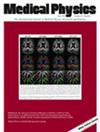High-resolution TOF-DOI PET detectors through the implementation of dual-ended readout with SiPM arrays of different pixel sizes on the two ends
Abstract
Background
An organ-specific Positron emission tomography (PET) scanner can achieve the same sensitivity with much fewer detectors as compared to a whole-body PET scanner, thereby substantially reducing the system cost. It can also achieve much better spatial resolution as compared to a whole-body PET scanner since the photon noncollinearity effect is reduced by using smaller detector ring diameter. Consequently, the development of organ-specific PET scanners with high spatial resolution, high sensitivity, and low cost has been a major focus of international research in PET instrument development for many years.
Purpose
The focus of this work is to develop high-resolution depth encoding PET detectors with high timing resolution and a reduced number of signal processing electronic channels. Consequently, PET scanners tailored for specific organs can be developed with high spatial and timing resolutions, enhanced sensitivity, and affordable cost.
Methods
An 8 × 8 silicon photomultiplier (SiPM) array with a pixel size of 3 × 3 mm2 and a multiplexed signal readout circuit is coupled to one end of the lutetium yttrium orthosilicate (LYSO) array with a glass light guide between them to achieve a good crystal identification of small crystals by using only four position-encoding energy signals. A 4 × 4 SiPM array with a pixel size of 6 × 6 mm2 and an individual readout circuit is coupled to the other end of the crystal array without a light guide to achieve a good coincidence timing resolution (CTR). The depth of interaction (DOI) of the detector is measured by ratio of the energies measured by the two SiPM arrays and can be used to correct the depth dependency of the timing. The flood histograms, energy resolutions (ERs), DOI resolutions, and CTRs of two detectors utilizing LYSO arrays with different crystal sizes were measured with each of the two SiPM arrays alternately placed at the front of the detectors.
Results
A better flood histogram was obtained by placing the 8 × 8 SiPM array in front of the detector. The depth dependency of timing was larger when the 4 × 4 SiPM array was placed at the front of the detector. A better CTR was obtained by placing the 4 × 4 SiPM array at the back of the detector as compared to placing it at the front of the detector if the depth-dependent timing correction was not performed. If the depth-dependent timing correction was performed, a better CTR can be obtained by placing the 4 × 4 SiPM array at the front of the detector. The first detector using a 12 × 12 LYSO crystal array with a crystal size of 1.95 × 1.95 × 20 mm3 provided a flood histogram with all crystals clearly resolved, an ER of 11.7%, a DOI resolution of 2.9 mm, and a CTR of 275 ps with the depth-dependent timing correction. The second detector using a 23 × 23 LYSO crystal array with a crystal size of 0.95 × 0.95 × 20 mm3 provided a flood histogram with all but the edge crystals clearly resolved, an ER of 17.6%, a DOI resolution of 2.3 mm, and a CTR of 293 ps with the depth-dependent timing correction.
Conclusions
PET detectors with small crystal cross-sectional sizes, good DOI and timing resolutions and a reduced number of electronics channels were developed. The detectors can be used to develop high performance organ-specific PET scanners.

 求助内容:
求助内容: 应助结果提醒方式:
应助结果提醒方式:


